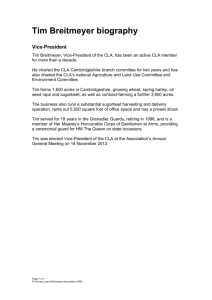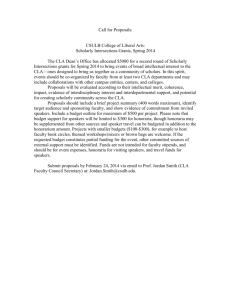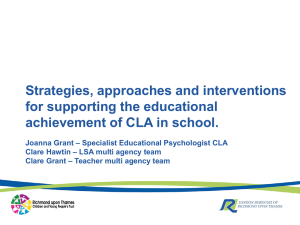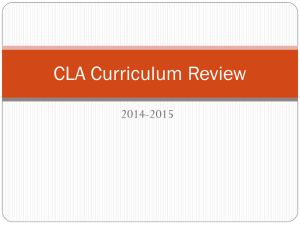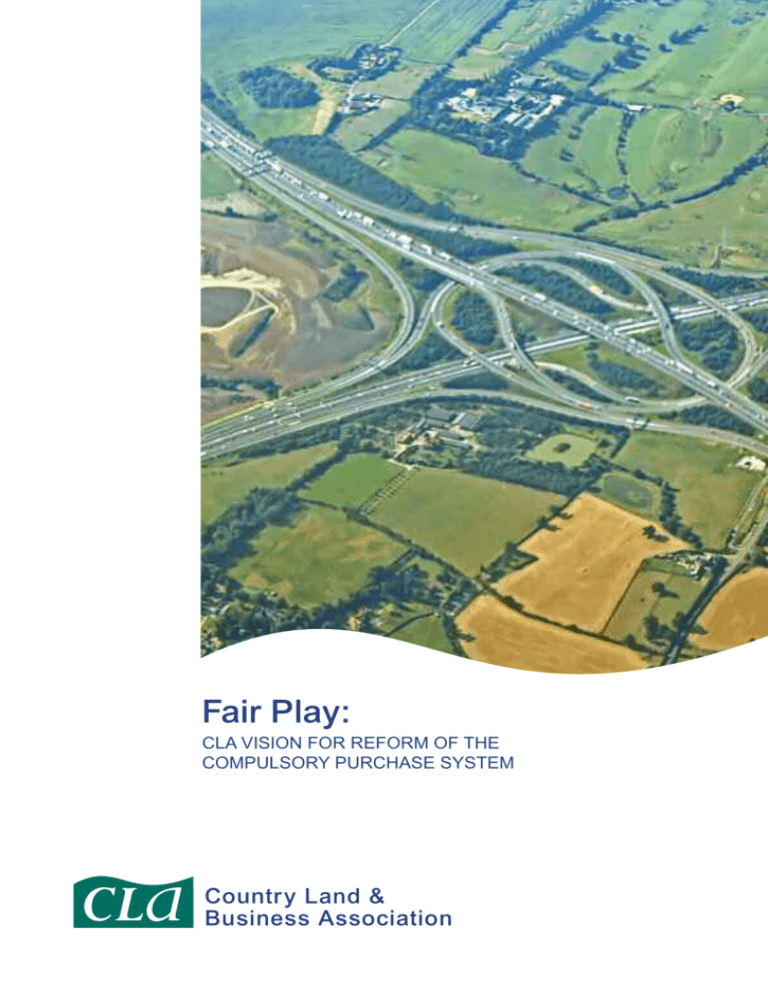
Fair Play:
CLA VISION FOR REFORM OF THE
COMPULSORY PURCHASE SYSTEM
Country Land &
Business Association
CONTACTS
For more information on Fair Play: CLA vision for reform of the
compulsory purchase system, published in November 2012, contact:
Andrew Shirley MRICS
Chief Surveyor
Country Land and Business Association
16 Belgrave Square
London SW1X 8PQ
Tel: 020 7235 0511
Fax: 020 7235 4696
Email: andrew.shirley@cla.org.uk
www.cla.org.uk
Tim Broomhead MRICS FAAV
Regional Surveyor
Country Land and Business Association
Hikenield House
East Anton Court
Icknield Way
Andover
Hampshire
SP10 5RG
Tel: 01264 313434
Fax: 01264 369196
Email: tim.broomhead@cla.org.uk
www.cla.org.uk
© Country Land and Business Association Limited 2012
Registered in England and Wales No: 6131587.
Registered office: 16 Belgrave Square, London SW1X 8PQ.
All rights reserved. No part of this publication may be reproduced or transmitted, in any form or
by any means, electronic, mechanical, photocopying, recording or otherwise, or stored in any
retrieval system of any nature without prior written permission of the copyright holder except as
expressly permitted by law.
Country Land &
Business Association
FOREWORD
In this report the Country Land and Business Association (CLA) puts forward proposals for
reforming the compulsory purchase system, by making fairness its cornerstone.
We do this after having consulted with our members and professionals with extensive experience
at the sharp end of the compulsory purchase system.
Compulsory purchase goes to the heart of the relationship between private property owners with
very limited resources and the might of statutory authorities or those private companies
contracted to deliver infrastructure on the State’s behalf.
Many of the CLA’s 34,000 members, who own and manage around half the rural land in England
and Wales, are regularly involved in this process. They are affected by acquisitions for new or
widened roads, rail, airports and utilities as well as land for schools, hospitals and even, in some
cases, private development.
Our concern is that the current system, which has arisen piecemeal over more than a century,
fails to balance the perceived requirements for infrastructure and the rights of the private
landowner.
The inherent unfairness and imbalance of the current system inevitably lead to conflict and delays
increasing the costs for acquirers as well as those affected as they navigate the bureaucratic
nightmare of the compulsory purchase system.
Our reform proposals set out an approach which will deliver a better balance between the
interests of the parties, reduce conflict and lead to better projects that take into account the
impacts on those affected, and mitigate them better.
The impact of compulsory purchase begins many years before acquisition in the form of
generalised loss of property value – known as blight. Conflict heightens during the planning and
acquisition stages which often pan out over many painful years before the construction of the
project.
CLA members and others who own rural property generally face the worst of both worlds: not
only is their land and property being acquired compulsorily but they are usually forced to tough
it out in the same location, remaining in their homes and adapting their businesses to fit in with
the project. Farmers often have their holdings split, causing irreparable damage to their
businesses. They are financially and logistically hit. This is invariably not fully recognised in the
current system.
Compulsory purchase has a significant impact on people, their lives and their aspirations, which
adds a moral urgency on top of the business case for reform.
All those who regard property rights as important and care for rural communities under threat
should join us in this call for reform. The proposals for the second high-speed rail line – HS2
London to Birmingham and the North – make this particularly urgent.
The time is right for reform of the compulsory purchase system.
Harry Cotterell
President, CLA
Fair Play: CLA vision for reform of the compulsory purchase system 2012
1
ACKNOWLEDGEMENTS
The CLA thanks the many organisations, professionals and claimants
whose experiences have informed this report. Prior to this report being
written, the NFU and the Central Association of Agricultural Valuers (CAAV)
were consulted. We have also welcomed submissions and evidence from
those who have contributed their experiences and advice.
LIST OF ABBREVIATIONS
2
CPO
Compulsory Purchase Order
CPPRAG
Compulsory Purchase Policy Review Advisory Group
IDWGB
Interdepartmental Working Group on Blight
Fair Play: CLA vision for reform of the compulsory purchase system 2012
Fair Play:
CLA vision for reform of the compulsory purchase system
CONTENTS
Page
Executive Summary
5
1.
The CLA and Compulsory Purchase
6
2.
Fairness and a Duty of Care
8
2.1 Duty of Care
8
3.
4.
2.2 The Independent Person
10
2.3 Code of Practice
10
Blight
14
3.1 Statutory Blight
14
3.2 Generalised Blight
15
3.3 Market-based Bond Property Purchase Guarantee Scheme
15
Land no longer required (Crichel Down Rules)
16
Fair Play: CLA vision for reform of the compulsory purchase system 2012
3
4
Fair Play: CLA vision for reform of the compulsory purchase system 2012
EXECUTIVE SUMMARY
The compulsory purchase system as it stands is
inefficient and unfair to those whose land is taken from
them. In this report the CLA sets out its vision for
changing the system for the better.
We have long argued compulsory purchase should
be used only as a last resort. Acquirers should have
to show they have fully negotiated with, and sought
remedies for, affected landowners.
The present system fails to address the legitimate
losses of those whose property is taken. We believe
our reforms would improve the system at no additional
cost.
The CLA says that a reformed compulsory purchase
system must, therefore, include the following key
provisions:
• a duty of care with an enforceable code of
practice;
• fairer compensation provisions with mitigation;
Loss Payments
The CLA believes that loss payments should be
increased to 30 percent of the value of the claim to
reflect that the sale is forced to take place not at a time
of the claimant’s choosing and to cover numerous
other incalculable losses suffered during the entire
process.
Blight
The impact on the value and marketability of property
near to an infrastructure project is the scourge of
landowners. It paralyses businesses, destroys property
values and damages the security of lending for
homeowners and private enterprise, sometimes with
terrible effects on its victims. A property bond scheme
would underpin both property values and the market
throughtout the period of the scheme but would still
allow property owners to force acquirers to purchase
blighted property.
• a property purchase guarantee scheme to deal
effectively with blight; and
• the duty to take only the minimum amount of land
permanently required and return any land that
becomes surplus at any time.
Fairness and a Duty of Care
Fairness is currently not the cornerstone of the
compulsory purchase system. We must change this
through a new duty of care that acquirers will have to
claimants.
Crichel Down and the Return of Surplus Land
The CLA believes there is no justification for the
acquirer to retain land purchased by compulsion, or
threat of compulsion, when the use for which it was
bought has either ceased or been abandoned. The
current non-statutory Crichel Down rules are
inadequate.
A requirement to offer it back to the original owner
must be enshrined in law and there should be no time
limit on this obligation.
Code of Practice and an Independent Person
Cost of our Proposals
The CLA proposes that the Land Compensation Act
1961 should be amended to make sure acquirers
adopt an approved Code of Practice of which an
essential part would be the appointment of an
Independent Person to supervise the implementation
and enforce the Code. This statutory Code and the
Independent Person are essential to regulate the
conduct of both acquisition procedures and
construction works.
The present system fails to address the legitimate loss
of those whose property is taken. We believe the
overall cost of our proposals will be neutral. Our
proposals will benefit acquirers through savings in
cost and time and claimants through the knowledge
that the acquirer is duty bound to treat them fairly,
reducing the need for challenge and establishing a
trust between the parties.
This report expands on these themes.
Valuation
The present valuation rules favour the might of the
acquirer. This needs to be rebalanced to ensure that
the property owner does not lose out. There needs to
be a genuine recognition of open market value,
replacement costs and other costs.
Fair Play: CLA vision for reform of the compulsory purchase system 2012
5
1. THE CLA AND COMPULSORY PURCHASE
The CLA represents 34,000 members who collectively
own or manage approximately half the rural land in
England and Wales and more than 250 different types
of businesses.
The members are individuals, businesses, charities,
farmers and estate managers. They generate jobs,
provide land and buildings for investment, and
housing for local people as well as producing food,
fibre and a wide range of land-based environmental
services. They also manage a significant proportion
of the heritage properties in England and Wales.
Compulsory purchase is a fundamental challenge to
property ownership. We recognise compulsory
purchase may be a necessary tool to deliver largescale infrastructure projects for the public good.
However, it does not follow that the public interest is
served by the State or other bodies using their
dominant position and often confrontational approach
to acquire land on any lesser terms than if it were sold
voluntarily on the open market.
The dominance of the State and other acquirers is
often demonstrated by the situation when a landowner
challenges, at inquiry or tribunal, the compulsory
purchase process. Success or partial success does
not automatically entitle the landowner to recover his
costs in making that challenge.
Moreover, the imposition of large-scale infrastructure
projects and the acquisition of people’s homes and
businesses inevitably cause stress to those affected.
Indeed, it can produce great trauma to those involved
in significant drawn-out cases.
CLA members face threats of compulsory purchase
of land and rights over land arising from more than 40
different Acts of Parliament. This statute and case law
dates from the time of the British Empire and has
been amended piece by piece. The ability of
privatised and other profit-seeking businesses to use
compulsory purchase powers is also a major
concern. Such powers have real commercial benefit
and give unwarranted strength to such businesses.
The confrontational nature of the compulsory
purchase process makes most rural landowners
naturally want to fight any proposal likely to lead to
compulsory acquisition of their land. Owners should
not feel they have to adopt an adversarial approach
to protect their interests. This is the unfortunate
position at present and costs both the landowner and
the acquirer dearly.
The CLA has long argued that compulsory purchase
should only be used as a last resort. Acquirers should
be compelled to show that they have fully negotiated
and sought remedies for the dispossessed landowner.
6
No acquirer should have recourse to compulsory
purchase powers without having tried to reach an
agreement with the owner. Faced with a difficult
negotiation, it is far too easy at present for an acquirer
to serve notice and take possession and leave the
claimant to argue his case for compensation after
losing his land. This report seeks to show much can
be gained by both acquirers and claimants through
our proposals.
It is more difficult for those living and working in rural
communities, including many CLA members, to sell
up and move to another location than for those living
in urban locations. A CLA member who loses an entire
farm, for example, is very unlikely to be able to find a
similar property on the open market without, perhaps,
waiting many years or moving to an entirely different
part of the country. Family and geographical ties for
rural landowners are strong and therefore many do
not move. Thus, the accommodation and mitigation
works provided as part of any scheme are central to
our members’ interests.
Blight is the scourge of landowners, paralysing
businesses, destroying property values, causing
property markets to seize up and damaging the
security of lending for homeowners and private
enterprise, sometimes with desperate effects on those
who lose out.
In the countryside, those who have land taken often
remain as neighbours to the large construction
projects and resultant developments that have an
enduring effect on their homes, businesses and lives.
The impacts of the high-speed rail Channel Tunnel
Link (HS1) project on a swathe of rural Kent caused
enough concern in Parliament in the 1990s for the
Fair Play: CLA vision for reform of the compulsory purchase system 2012
Government to commission the Interdepartmental
Working Group on Blight (IDWGB)1 and the
Compulsory Purchase Policy Review Advisory Group
(CPPRAG)2, and this was followed by a Law
Commission study3.
The CLA finds it shocking that almost none of the
recommendations made in these important reports
have been implemented. After nearly a decade since
the Law Commission’s report, we believe the time is
right to highlight the issue and bring some fresh ideas
to the debate. This would help claimants without
needing to have a new consolidating Act, although we
would welcome this outcome.
The aim of our proposals is to reduce the likelihood
of the claimant and the acquirer ending up in conflict.
The key is for the acquirer to recognise and
acknowledge its powerful position legally and
financially over the landowner and not to abuse this
relationship.
CPO tragedy
A Welsh sheep farmer, who had a substantial
proportion of his holding acquired, had to rent
additional land on which to graze his stock.
His agent submitted and agreed the farmer’s
claim with the district valuer and vigorously
chased the acquirer for payment. Four years of
non-payment followed with spurious excuses
such as “the girl who writes the cheques is on
holiday”.
The acquirer also claimed to have lost the
paperwork submitted by the claimant.
The saga ended tragically when the bank
foreclosed on him and he took his own life.
The CLA wants to see a new approach to compulsory
purchase – one that makes fairness the cornerstone
of a project. This happens in Australia4, where greater
attention is given to the need for fairness, especially
for those who must give up their land for the public
interest. The approach also makes sure that if that
land is no longer needed for the original purpose, the
former owner has the right to its return.
We are lobbying for a compulsory purchase system
with a compensation mechanism that works.
Currently, the system fails to protect the interests of
those who will be required to sacrifice their property.
1.
2.
3.
4.
Interdepartmental Working Group on Blight Final Report and Draft Property Purchase Guarantee and Compensation Scheme, DETR, 1997
Fundamental review of the laws and procedures relating to compulsory purchase and compensation (the Final Report of the Compulsory Purchase Policy Review Advisory Group),
DETR, 2000
Towards a Compulsory Purchase Code (1) Compensation (Law Com No 286), 2003, and (2) Procedure (Law Com No 291), 2004
See www.alrc.gov.au/report-14 – now enacted in the State of Victoria with a “duty to be fair”
Fair Play: CLA vision for reform of the compulsory purchase system 2012
7
2. FAIRNESS AND A DUTY OF CARE
Current compensation is bound by rules that play to
the relative strength of the acquirer who will always
have more resources than the claimant. The acquirer
also benefits from the requirement to pay
compensation of no more than the claimant’s loss.
There is virtually no incentive or requirement for
acquirers to act promptly, resulting in compensation
often being paid many years after compulsory
acquisition takes place.
Valuers are governed by the six rules of
compensation in Part II of the Land Compensation
Act 1961 which are summarised below.
1. No allowances shall be made on account of the
acquisition being compulsory.
2. The value of land shall be the amount that it would
realise if sold in the open market by a willing seller.
3. The special suitability of the land for any purpose
shall not be taken into account if it could be applied
by a body with powers of compulsory purchase.
4. Where illegal activity has increased the value of
land, this increase will not be taken into account.
5. Where land has no market value, it will be assessed
on the basis of the reasonable cost of equivalent
reinstatement.
6. The value of the land in Rule Two shall not affect
the assessment of compensation for disturbance
or any other matter not directly based on land value.
The upshot of these six rules is that claimants are
generally paid less than their loss, especially as some
losses are not accurately quantifiable.
The CLA is not alone in reaching this conclusion.
Indeed, in 2000 the then Government’s own review of
compulsory purchase (CPPRAG) said: “We have
therefore come to the conclusion that open market
value seems to present the fairest basis for assessing
the compensation payable for the land taken.
However, as previously mentioned, valuation cannot
be an exact science and the application of the
principles used to define open market value will
always produce a range of figures. We would
therefore wish to encourage acquiring authorities to
consider whether there would be advantage in
adopting a more flexible approach to negotiations
on the open market value of any particular site within
the limits set by such principles.”
Following this, the Law Commission in its report
Towards a Compulsory Purchase Code stated that the
“overriding objective was fair compensation”.
Because of the abject failure to carry out these muchneeded reforms, the CLA now proposes in this report
the introduction of a new duty of care between the
acquirer and landowner which would govern their
conduct. If enshrined in law, such a duty of care
would allow both a flexible approach, as recognised
by CPPRAG, and fair compensation, as recognised
by the Law Commission, which would go some way
to correcting the imbalance in the compulsory
purchase system that exists today.
Fees owed
Valuation Issues
Property valuation is an art rather than a science. The
acquirer’s valuer is limited to offering a sum that is no
more than his assessment of the loss, which is purely
an opinion. Unfortunately, this is often at the low end
of the range of values that might be achieved in
practice on the open market.
Two valuers could be as far apart as 20 percent in
their valuations of the same property and, yet, both
may be considered correct. Valuers acting for
acquiring authorities naturally seek to do the best deal
for their client during negotiations and often only offer
the bare minimum. These valuers frequently justify
their position on the basis that the acquirer is required
to pay no more than the loss.
The CLA believes the problem is not the six rules of
compensation but what might be described as their
over-zealous application to the acquirer’s advantage.
This is not helped by the costly and adversarial nature
of any appeal.
8
A CLA member in Herefordshire said: “With
nearly 30 years’ experience in this, I have to
admit to being appalled at the Government’s
disrespect for the law it puts into place.
“I have more than £40,000 of fees outstanding
relating to compensation claims which date back
as far as 1994.”
2.1 Duty of Care
The CLA’s approach to the widely recognised
inadequacies of the current system does not call for
wholesale legislative change. While we believe, in
common with the Law Commission, that consolidation
of statute and case law is needed and long overdue,
our proposal seeks changes to the existing law that
would bring about a fundamental change in the
working practice of those bodies with compulsory
Fair Play: CLA vision for reform of the compulsory purchase system 2012
purchase powers. This change is one of fairness
through a duty of care, which we believe an acquirer
owes to a claimant from the moment a project is
conceived to the completion of works.
The Duty of Care should include:
• acting fairly;
• consulting claimants and their immediate
neighbours before and during acquisition;
• minimising the impact on claimants and immediate
neighbours;
• recognising the special position of, and consulting
with, the land managers remaining at or beside the
project’s site after the scheme’s completion;
• acting transparently in negotiations over
accommodation works including fences, bridges,
underpasses, gates and other mitigation measures
provided by an acquirer;
• maintaining and providing up-to-date contact
details for ongoing management issues involving
the scheme and providing other relevant
“aftercare”;
• ensuring effective dispute resolution;
• indemnifing claimants against losses caused by
acquirers, their agents, staff, contractors and
sub-contractors; and
• paying compensation promptly.
To achieve fairness we propose the rules of
compensation in The Land Compensation Act 1961
should be bolstered by a new provision that those
acting on a Compulsory Purchase Order (CPO) or
backed by the shadow of compulsion (where an
acquirer purchases a property by agreement that
would otherwise be subject to a CPO) should have an
overriding duty of care to claimants.
5.
Broken promise
The Highways Agency took around 24 acres of
land to use for storage of soil removed during
by-pass construction at Haydon Bridge in North
Yorkshire with a promise to return the land in
good condition after work was complete.
Two years later, the land has been left in an
appalling condition and the Agency refuses even
to respond to correspondence.
The land agent said: “We have been contacting
the Agency almost incessantly for months and it
has deferred numerous meetings.”
The CLA recommends that an additional rule of
compensation should be added to the six rules set
out above. Rule Seven would say:
“In assessing compensation an acquirer should at all
times exercise a duty of care to the claimant and act
fairly and reasonably within a code of practice. Failure
to adhere to this Duty of Care would lead to financial
penalties being imposed by either the Independent
Person5 or the courts.”
The ways in which the Duty of Care would be
discharged should be set out in a code of practice
with enabling powers created by the Government
through secondary legislation.
Such codes of practice, while sharing a common
theme, would be specific to either a particular
industry or scheme. In the case of a specific scheme,
the Code of Practice would be agreed and in place
before the planning phase of the scheme started.
See 2.2 for a description of the Independent Person
Fair Play: CLA vision for reform of the compulsory purchase system 2012
9
2.2 The Independent Person
It is the responsibility of the Independent Person,
highlighted in the new Rule Seven, to ensure the
acquiring authority fulfils its duty of care and its
obligations under the Code of Practice.
Every acquirer must appoint such an Independent
Person to act as ombudsman to ensure fair play and
compliance with the Code of Practice.
'Mean' valuers
A professional member of the CLA in the
Midlands said: “There are certain valuers
working on behalf of acquiring authorities who
are known to be ‘mean’ with their figures and
refuse any form of negotiation – the idea of an
independent person would effectively deal with
this situation.”
Independent Person, is required to regulate the
conduct of acquisition and construction works. All
major infrastructure projects should be required to
adopt such a code agreed with representative
organisations which will become a basic requirement
for managing projects involving Compulsory Purchase
Orders.
This Code should provide undertakings by the
acquirer on consultation, communication, notice of
entry, construction practices and protection of
adjacent land and services, together with provisions
to cover dispute resolution and ancillary issues. It
should be enforced by the Independent Person and
provide real protection for those who are affected by
a project.
The CLA believes that a well-drafted code of practice
could effectively deal with the pressing issues faced
by claimants, in particular farmers and rural
landowners, where the current system either fails
completely or is inadequate in other ways.
2.3.1
The Independent Person should be an expert who
can exercise professional judgment to enforce the
Duty of Care and Code of Practice and act as a
mediator between claimants and acquirers. Where a
problem is identified by a claimant, the Independent
Person would have a duty to report, with
recommendations, on the actions required to put
matters right, seeking specialist advice if necessary.
The Independent Person would also have the power
to impose penalties for breaches of the Duty of Care
and the Code of Practice.
Having an Independent Person would achieve two
main goals:
1. the acquirer is likely to act fairly and reasonably
from the start; and
2. any disputes that arise would be dealt with swiftly
and cost effectively.
Time and cost savings would be considerable and
would, the CLA believes, benefit the acquirer, and the
overall benefit would be a fairer system with reduced
conflict.
The existence of an Independent Person would not
preclude the claimant taking the matter to the
specialist Upper Tribunal (Land Chamber) – the
former Lands Tribunal – for formal resolution at any
point. This would be with or without previous reference
to the Independent Person.
2.3 Code of Practice
A statutory code of practice, backed by low-cost and
user-friendly enforcement procedures through the
6.
10
Loss Payments
The CLA believes loss payments6 are vital to achieve
fairness. We have identified where the system is unfair
to the claimant, particularly those with rural
businesses. However, the current loss payment
system is still inadequate in terms of its percentage
and the capping measures in place.
We propose these loss payments should be
increased to 30 percent of the value of the claim.
Such a percentage would reflect that the sale is
forced at a time not of the claimant’s choosing as well
as hard-to-quantify impacts of the compulsory
purchase. This would be an appropriate payment over
and above the value of the property taken, as
uncompensated losses always arise. This could go
some way to reduce the adversarial nature of the
process and should not represent a windfall gain.
The CLA believes the cost of this approach would be
offset by savings in time and expense for acquirers in
defending the scheme through complex inquiries and
legal challenges, which are often driven by the real
concerns that claimants have about the existing
compensation system.
2.3.2
Replacement Buildings
Farms and other rural businesses often find that
compensation in cash terms fails to meet their needs,
particularly where farm buildings and houses may be
taken by the project, or physically cut off from the
farm so they are no longer viable or significantly less
valuable. The market value of farm buildings may be
low but these buildings will often be essential to the
running of the business. Reform should recognise that
provision should be made for the replacement cost
where essential buildings have been taken.
Land Compensation Act 1973 as amended by the Planning and Compulsory Purchase Act 2004
Fair Play: CLA vision for reform of the compulsory purchase system 2012
A further issue arises in relation to farm and other
buildings located in the greenbelt and other protected
areas: planning policy may stop the replacement of
farm or other rural buildings and, in particular,
replacement dwellings in the countryside. The CLA
argues that landowners should be able to include
replacement assets on their remaining land –
including “planning consent” for replacement
buildings and dwellings – as part of the project’s
accommodation mitigation works.
The CLA recommends that the current Rule Five
should be amended to provide equivalent
reinstatement for essential housing and buildings
taken by a scheme, which may have a market value
but cannot be replaced. It should state that a claimant
should have the ability to seek that the acquirer should
provide both the planning consent and the cost of
replacing such assets rather than their market value.
This is appropriate when it is clear that equivalent
reinstatement cannot be achieved on a holding
without the intervention of the acquirer.
2.3.3
Advanced Payments
An acquirer is required to make an advance payment
of compensation of 90 percent of the acquirer’s
estimate of compensation. The claimant is required to
request such a payment in writing. At the present time,
claimants, even after a written request, are unable to
compel the acquirer to make advance payments – a
fact recognised by the Law Commission in its report
Towards a Compulsory Purchase Code.
The proposed Code of Practice should make it an
obligation for acquiring authorities to assess
accurately compensation, on which to base the 90
percent, and then make advance payments on the
day it takes possession of the property.
The Law Commission recommended enforcement
through the county court, a process which is slow and
costly. The CLA proposes that scrutiny of the
accuracy of the acquirer’s assessment and
enforcement be undertaken by the Independent
Person.
The CLA recommends that a schedule of advance
payments is submitted to the Independent Person for
his agreement prior to entry to ensure a fair advance
payment is made. Claimants would be able to make
representations to the Independent Person as to their
assessment.
To guarantee a reasonable assessment is submitted
by the acquirer, the Independent Person would have
the ability to impose a punitive rate of interest
between the advance payment and the eventual
settled figure.
7.
2.3.4
Accommodation Works
The Code needs to compel the acquiring authority to
design and to be bound to deliver a full scheme of
accommodation works agreed with the claimant. The
CLA often finds that promises are broken by acquirers
when it comes to accommodation works. The Code
of Practice will oblige the acquirer to enter legally
binding agreements specifying the scope and extent
of accommodation works.
2.3.5
Timing of Notices
At present an acquiring authority has a significant
amount of time in which to exercise a purchase. Once
a CPO has been confirmed, an acquirier has three
years to serve a Notice to Treat7. After that, the Notice
to Treat remains valid for a further three years.
Potentially a claimant can have up to six years of
limbo. The CPPRAG advised the shortening of this
period to three years with the ability of a claimant to
serve a reverse Notice to Treat. The CLA believes this
is the correct recommendation to reduce the time in
which acquirers have to bring forward a scheme.
2.3.6
Amount of Land Acquired
Frequently, acquirers seek to compulsorily purchase
more land than is needed for the operation of the
finished scheme. This additional land is usually to
make construction easier. The CLA believes that such
additional land should be only taken under temporary
licence for the time period of the works and under
commercial terms and not retained.
A notice served by an acquiring authority seeking to “treat” (negotiate) with the claimant over the amount of compensation payable
Fair Play: CLA vision for reform of the compulsory purchase system 2012
11
2.3.7
Payment of Compensation
Claimants often find it almost impossible to enforce
prompt payment of compensation including advance
payments and fees. Most businesses require
settlement of accounts within 30 days and apply
penalties after that. A similar provision should be
made for agreed compulsory purchase compensation.
2.3.8
The acquirer should be responsible for all the
reasonable costs incurred by the claimant. Often
schemes fail to go ahead due to changing political
and financial priorities. Where landowners and
businesses have incurred costs due to an abortive
scheme, they should be compensated for those costs.
Interest
The current statutory rate of interest is half a percent
below the Bank of England base rate. At present, with
a Bank of England base rate of 0.5 percent, this
means that no interest whatsoever is payable by the
acquirer. Clearly, this is unacceptable and does not
reflect the cost to rural business of borrowing money.
It means there is no incentive for any acquiring
authority to agree and pay promptly. The CLA calls for
commercial rates of interest to be paid on a
compound basis. The Independent Person and the
Upper Tribunal (Land Chamber) should also have the
power to award punitive rates of interest (and wider
compensation) when justified by the conduct of the
acquirer.
2.3.9
2.3.10 Costs
Betterment
Betterment is the increase in value of a claimant’s
land, or part of it, by virtue of the scheme. At present,
betterment is deducted from all heads of claim. The
CLA believes, as recommended by the Law
Commission, that betterment should only be
deducted from the severance and injurious affection
heads of claims and not from the value of the land
taken.
Derailed
A CLA member in Wales was the owner of a
colliery served by a private rail siding. He had his
railway dismantled when the Highway Authority
built a new road bridge over the line which was
too low to allow trains to pass underneath. His call
for a different design was turned down.
This prevented the re-opening of the colliery and
future income and employment opportunities
were lost forever.
Subsequently, the Highway Authority has changed
twice. This has resulted in new people dealing
with the case and the claim remains unsettled.
The new Authority has no incentive to deal with
what it sees as someone else's scheme. The
statutory interest rate, currently zero percent, is
unlikely to encourage any progress by the
acquiring Authority.
The member says: “Twenty-two years later, you
lose the will to live.”
2.3.11 Water Industry
The power of water companies to serve notice to
enter land to lay new pipes and drains is used often
without any prior negotiation with the landowner or
regard to the consequences to the management of
that land. This contrasts starkly with the behaviour of
companies in the gas industry where the CLA and
NFU have in the past facilitated a national agreement
which includes provision for owner’s and occupier’s
payment together with agreed legal documentation.
This has reduced the need for the gas industry to
seek formal compulsory purchase orders to lay pipes.
All acquirers should be bound to consult and
consider all land management issues arising from
their proposals and be bound by the Code of Practice
12
Fair Play: CLA vision for reform of the compulsory purchase system 2012
2.3.12 Heritage Property
2.3.15 Mitigation
Often heritage property is owned under complex
structures which can give rise to an artificially lower
level of compensation than the real loss incurred. This
imbalance needs to be redressed.
The impact of any scheme not only affects those who
are having land compulsorily acquired but also those
in the vicinity. This impact can start from the time the
proposal becomes public, through the planning and
construction phase to completion. At all stages, there
are matters that the acquirer can deal with that can
reduce that impact.
Too risky
A heritage property, held in trust precluding an
open-market sale, lost five acres of land from the
estate to a railway scheme. As a result of its
status, the Trust was unable to make a successful
claim against the acquirer for injurious affection.
A CLA Kent member said: “The Trust employed a
valuation expert, noise consultant, landscape
consultant, its own team of solicitors and a QC.
Despite all of this, we were faced with the option
of a Lands Tribunal hearing with no certainty of
the outcome.
“If the Trust had lost, there was the prospect of
paying not only our own but also the other side’s
costs which could have amounted to several
hundred thousand pounds. The trustees agreed
that it would not be prudent to take the risk with
charitable funds.”
2.3.13 Contractors’ Indemnity
The Code should require that acquirers have fully
indemnified liability for all losses incurred by
claimants because of the actions of contractors and
sub-contractors.
2.3.14 Future Value
The Code of Practice needs to make sure that where
land is taken for a specific public purpose and is
subsequently developed for a commercial use after
the original purpose has ceased, any uplift in value
arising from the subsequent development is shared
with the former owner.
The Planning and Compensation Act imposes a limit
of 10 years from the completion of the compulsory
purchase transfer. The CLA believes that this time limit
should be extended significantly to protect owners
and their successors, particularly when that owner or
successor remains in possession of adjoining land.
The Code of Practice needs to make sure that the
acquirer shows it has considered all appropriate
mitigation measures throughout the scheme’s life to
lessen the impact on affected property owners.
Claimant 'cheated'
A claimant in Yorkshire found that the final
design of a project provided just half the width
of access originally promised and was therefore
wholly inadequate for his purposes. His agent
said: “Overall I believe my client has been
cheated on this.”
The failure of acquirers to agree works to
mitigate the ill effects on the claimant as part of
the design often leads to unfairness and
problems for claimants.
In most cases, acquirers will prepare
“illustrative” drawings of what is proposed for
use at public inquiry subject to final design.
Commonly, these change before the project is
built. So, what is promised by way of mitigation
to secure authority for the CPO is not delivered.
Claimants are invariably told that all drawings
and designs are for illustrative purposes only.
This is unjust and misleading.
2.3.16 Negotiation before Service of Notice
It is important that all acquirers use compulsory
purchase only as a last resort and, therefore, it is
necessary for them to show they have taken a
proactive and flexible approach to negotiating for
voluntary purchase before resorting to compulsory
purchase.
Development uplift clauses will be familiar to many
landowners and professionals selling land on the
open market. Such development uplifts (or clawbacks)
are commonly terms of 20 years to 50 years. We
believe that a landowner should be given the
opportunity to negotiate a time limit to such an uplift,
as would be the case with an open-market sale.
Fair Play: CLA vision for reform of the compulsory purchase system 2012
13
3. BLIGHT
3.1 Statutory Blight
Statutory blight is only available once a scheme has
been confirmed and is “safeguarded” in the planning
system. In some cases this can be years from the
project conception. Only after this stage can an owner
serve a blight notice for the acquirer to purchase the
blighted property before the potential compulsory
purchase.
However, insufficient enforcement provisions in the
blight notice procedure mean acquirers can sidestep
the responsibility to purchase a property.
CLA members have found themselves under threat of
compulsory purchase for many years. Even where a
blight notice has been served, the claimant has no
means of requiring the early conclusion of the matter.
Landowners with business premises whose rateable
value exceeds £34,800 are prevented under the
Rateable Value Limits from serving a blight notice. The
CLA calls for the limit to be abolished.
Blight is a major problem associated with
infrastructure projects. In common parlance, blight
has a variety of meanings. First, blight has a statutory
meaning (statutory blight). Second, there is
generalised blight which is the effect on the value and
marketability of property in close proximity of an
infrastructure project.
Timescales are a major problem. Most transport
projects take a considerable time from conception to
completion. This is usually decades during which time
the scheme is often either changed or abandoned.
Long periods of blight can have a paralysing effect
on individuals and businesses.
In 1997 the Government established the
Interdepartmental Working Group on Blight (IDWGB)
in the wake of the significant issues arising from the
Channel Tunnel Rail Link (HS1) through Kent. The CLA
was a leading member of the Stakeholder Group that
worked with the IDWGB and made representations at
that time. The Working Group produced a report
which looked at statutory blight and generalised
blight. The report proposed a draft Property Purchase
Guarantee and Compensation Scheme, a type of
bond scheme.
Subsequent governments have failed to take account
of its recommendations. The HS2 proposal brings into
focus the issue of property market confidence over a
wide area caused by such proposals. The CLA
believes that the conclusions of the IDWGB were
broadly correct and the draft Property Purchase
Guarantee and Compensation Scheme should be
mandatory for all large-scale infrastructure projects.
14
Reform of statutory blight is long overdue. Existing
statutory blight provisions need to have an
enforcement mechanism through which a claimant
can compel an acquirer to undertake their blight
notice obligations. The CLA proposes that this
enforcement mechanism be dealt with by the
Independent Person proposed in 2.2.
A blight mess
A CLA member in Devon owns a house where a
small part of her garden is to be taken to improve
a road. The proposal has been in existence for
several years and planning consent has been
granted. As yet no CPO has been made.
The owner is keen to move from the property but
the acquirer has been stalling on the pretext of
waiting to learn the outcome of its own spending
review.
A blight notice was served and no counter-notice
was made, so the acquirer is obliged to purchase
the property but so far has refused to proceed.
There is no mechanism to help the blighted owner
to achieve a satisfactory and speedy completion.
Worse still, if the owner moves out early she will
no longer qualify for the Home Loss Payment,
even though the acquirer’s scheme would have
caused her to move.
Fair Play: CLA vision for reform of the compulsory purchase system 2012
3.2 Generalised Blight
Generalised blight affects all properties close to a
scheme as soon as it becomes public knowledge. For
linear infrastructure projects, in particular, scheme
promoters are bound to publish several option routes.
Even if the promoter has a preferred route, it needs
to consult and show why the alternatives are not
suitable. The problem it creates is significant
uncertainty in the property market in the vicinity of the
lines on the map. The impact of generalised blight is
at its highest at the beginning of a scheme.
If a market-based bond property purchase guarantee
scheme was in place when a new project is
proposed, the CLA believes opposition to such
projects would be significantly reduced, particularly
from residential owner-occupiers. Property owners
would feel assured the future value of their property
would be underpinned by the promoter, thus retaining
market stability. It is worth bearing in mind that the vast
majority of people whose property values would be
protected by the bond scheme would not be actively
trying to sell their property.
The CLA believes that a properly constructed scheme
akin to the Central Railway Property Protection
Scheme or the BAA Scheme should be mandatory
when a project is first announced. The IDWGB fell
short of recommending that the Property Purchase
Guarantee Scheme should include those properties
with no land taken but they too are often affected by
blight. Including properties which would eventually be
eligible for a claim under Part 1 of the Land
Compensation Act 19738 is essential to prevent blight
spreading.
A robust bond-type scheme would help promoters
with their projects. We do not believe such a scheme
would inevitably lead to the acquirer owning and
having to manage vast numbers of properties. A
secure index-linked bond is more likely to persuade
undecided property owners to stay if they have no
pressing need to move. Moreover, those marketing
and selling properties during the blighted period
before a scheme will be able to sell their property
subject to a transferable bond. Purchasers of these
properties will have the reassurance of either a bond
that can be realised in the future; alternatively they
would benefit from either full or part purchase through
a CPO or receive compensation under Part 1 of the
Land Compensation Act 1973.
The use of discretionary hardship purchase schemes
has been favoured in recent times. Mechanisms such
as the HS2 Exceptional Hardship Scheme do not
solve the problem for those with properties they
cannot sell. The arbitrary nature of the hardship
assessment does nothing to deal with the root of the
problem: market confidence.
8.
9.
Retirement blow
A CLA member in the Midlands was planning to
sell a substantial rural property to fund a smaller
house and his imminent retirement.
Because of the HS2 project, he has suffered
blight on the property he wants to sell. He applied
to the Exception Hardship Scheme for HS2 Ltd to
buy the property. However, because of his other
assets, HS2 Ltd decided he was not suffering
hardship.
The member feels that the blight is preventing him
from fulfilling his retirement plans, and that even
though he has other assets, it is unfair that the
damage done to his lifestyle and hopes for the
future is not deemed worthy of compensation.
With a bond scheme, it would have been far
easier for him to sell his property. Moreover, if this
had not proved possible, it would have been
purchased by the promoter regardless of his
other assets.
The option of a bond-based property purchase
scheme was favoured by 98 percent of those who
commented on the three options set out in the HS2
Consultation in 2011, including the CLA, the Council
of Mortgage Lenders and the British Bankers
Association9.
3.3 Market-based Bond Property Purchase
Guarantee Scheme
The concept of a bond-based purchase scheme is
that property owners can apply to the acquirer for an
undertaking to purchase the property at a future date.
This bond underpins the value of the property thus
giving confidence to lenders and future purchasers
that there will be a buyer for the property should they
wish to sell in the future.
This secures lending which is crucial to many small
businesses. A bond scheme has been operated
successfully by both BAA and Central Railway. A
description of the Central Railway scheme is in Annex
D of the IDWGB report.
In conclusion, the CLA believes that a properly
managed bond scheme is vital as an antidote to both
statutory and generalised blight. Reform of statutory
blight provisions is essential to ensure affected
property owners are treated fairly.
A claim for compensation for depreciation in value due to the physical factors of the scheme ie noise, vibration, smell, lighting etc. A claim can only be submitted 12 months
after the scheme has come into operation
DfT Review of Property Issues January 2012 paragraph 26
Fair Play: CLA vision for reform of the compulsory purchase system 2012
15
4. LAND NO LONGER REQUIRED (CRICHEL DOWN RULES)
There is no justification for the State to retain land that
was purchased by compulsion, or threat of
compulsion, when the use for which it was bought has
ceased or been abandoned. A statutory requirement
to offer it back to the original owner needs to be put
in place. The current non-statutory Crichel Down rules
are inadequate and uncertain.
In 2003, the Government proposed reform, in
particular the intention to put the rules on a statutory
footing. As with other compulsory purchase reforms
this was stymied by a lack of legislative time. In view
of the significant threats to the position of landowners
under compulsory purchase, the CLA argues there
should be action to protect their position.
which have been shown by the Government's own
research paper, The Operation of the Crichel Down
Rules (2000), to be largely ineffective.
There should be no time limit on the obligation to offer
compulsorily acquired property back to the original
owner. Because of the historical valuation context of
the compulsory purchase system, land was bought
for the public good at less than its true open market
value. It is fair and proper that once the purpose for
which it was acquired has ceased or been
abandoned, then the original buyer should have the
option to buy it back on the same basis as it was sold,
with no additional clawback provisions for the vendor.
This would enable the Government to introduce
regulations that would ensure the rules are applied
equally to all acquirers, rather than relying on
exhortation and recommendations as at present,
16
Fair Play: CLA vision for reform of the compulsory purchase system 2012
CONTACTS
For more information on Fair Play: CLA vision for reform of the
compulsory purchase system, published in November 2012, contact:
Andrew Shirley MRICS
Chief Surveyor
Country Land and Business Association
16 Belgrave Square
London SW1X 8PQ
Tel: 020 7235 0511
Fax: 020 7235 4696
Email: andrew.shirley@cla.org.uk
www.cla.org.uk
Tim Broomhead MRICS FAAV
Regional Surveyor
Country Land and Business Association
Hikenield House
East Anton Court
Icknield Way
Andover
Hampshire
SP10 5RG
Tel: 01264 313434
Fax: 01264 369196
Email: tim.broomhead@cla.org.uk
www.cla.org.uk
© Country Land and Business Association Limited 2012
Registered in England and Wales No: 6131587.
Registered office: 16 Belgrave Square, London SW1X 8PQ.
All rights reserved. No part of this publication may be reproduced or transmitted, in any form or
by any means, electronic, mechanical, photocopying, recording or otherwise, or stored in any
retrieval system of any nature without prior written permission of the copyright holder except as
expressly permitted by law.
Country Land &
Business Association
Fair Play: CLA vision for reform of the
compulsory purchase system
16 Belgrave Square
London SW1X 8PQ
T: 020 7235 0511
F: 020 7235 4696
E: mail@cla.org.uk
www.cla.org.uk
Country Land &
Business Association

